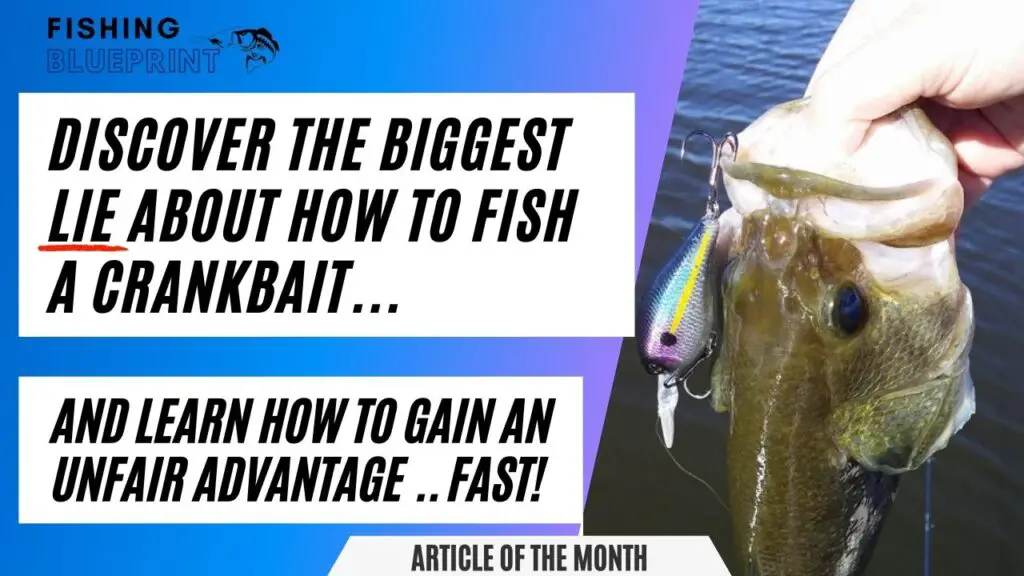Silverwood Lake Fishing
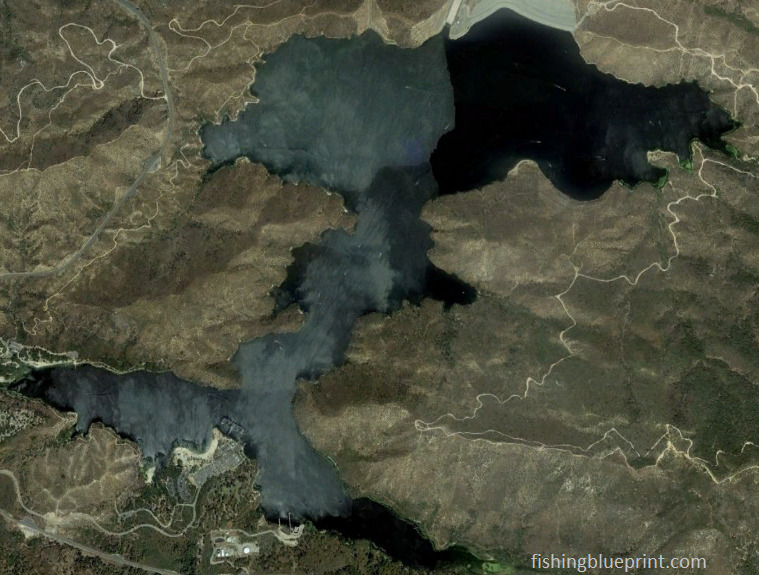
Silverwood Lake is a small man-made reservoir that sits 80 miles away from downtown Los Angeles, or 130 miles away from San Diego.
Overall it’s a popular weekend getaway lake and in this post you’re going to be given the blueprint to fish this lake.
So what are the best tips for Silverwood Lake fishing? There are three important factors you must know if you want to know how to fish Silverwood Lake successfully. First, you need to know what kind of fish is in Silverwood Lake. Second, it’s important for you to know which part of the lake each species can be found. Lastly, knowing what are the best baits that work on Silverwood Lake is vital. However, tactics, baits, and locations will be different for each type of fish that you target. So let’s talk about the steps you need to take in order to give you the best chance of catching a fish on Silverwood Lake.
Key Takeaways
This lake gives locals and visitors the opportunity to test their luck in catching one of the many game species this lake has to offer, such as Trout, Striped Bass, Largemouth Bass, Crappie, Catfish, Bluegill, and much, much more!
Here’s the most recent and updated Silverwood Lake Fishing Report – it gives you a quick and easy list of some really good fishing spots. If you’re looking for more detail on how to fish each spot scroll down into the article.
- Cleghorn Cove
- Miller Cove
- Rocking Chair Point
- The Narrows
- Chamise Bay
- Inlet Area
- Quarry Cove & Sycamore Landing
Here are some additional fast and helpful tips just for you:
- The easiest way to fish this lake is by boat, but there are areas to fish from the bank, or by kayak or float tube.
- There are multiple public boat ramps to use.
- Camping and RV parking is available.
- You can buy tackle and groceries at the lake or at one of the tackle shops in Crestline or San Bernadino.
About Silverwood Lake

Photo: inkknife_2000
Silverwood Lake is a shallow body of water with the average depth being 60 feet and a maximum depth of 166 feet when the lake is completely full. Being over three miles long, fishing at Silverwood Lake can be amazing when you have 13 miles of shoreline to fish. Silverwood Lake gives locals and visitors the opportunity to test their luck in catching one of the many game species this lake has to offer.
Important Lake Warnings
Algae blooms may be present which may affect fishing, swimming, and water contact in general.
According to parks.ca.gov, “every one of California’s new laws requires boat operators to have a California Boating Card. The card is required for anyone under the age of 41 to operate a boat in California’s waters.”
If you are fishing and camping, fire bans may be in effect due to the ongoing drought conditions.
What Kind Of Fish Are In Silverwood Lake
- Rainbow Trout
- Largemouth Bass
- Striped Bass
- White and Black Crappie
- Bluegill and Sunfish
- Catfish
Silverwood Lake Fishing Tips & General Strategies
Water clarity
First things first, let’s talk about the water clarity of this specific area. You’ll be happy to know that the water in Silverwood Lake is usually clear with a visibility of 4+ feet. However, there are times when the water is considered “moderately stained” with a visibility of 2-4 feet.
Structures & Cover
Now, let’s talk about the common types of structures and fishing cover you can find in Silverwood Lake. You can expect to find a variety of structures and cover that bass love to hang out in. Check out these examples:
- Rocky Points: Bass love to hang around rocky points and ledges. Cast your bait close to the shoreline and work it down the drop-offs.
- Weed Beds: Look for areas with dense weed beds where bass like to hide and ambush their prey. Use weedless baits to avoid getting snagged.
- Submerged Trees and Brush: Bass love to use submerged trees and brush for cover. Try using jigs and other baits that can work through the cover without getting snagged.
- Drop-Offs: Bass love to use drop-offs as ambush points. Cast your bait along the edge of the drop-off and work it down into the deeper water.
Springtime Fishing update
Here is the spring fishing update for Silverwood:
Water Temperature
The water temperature varied between 55 and 66 degrees F.
Water Clarity
The water clarity was consistently clear with a visibility of 4+ feet. However, there were a few instances where it was stained with a visibility of 2-4 feet.
Wind & Weather
The wind and weather conditions varied, with some reports mentioning windy conditions with speeds of up to 30 miles per hour. Some days were colder with temperatures as low as 30 degrees F, while others were warmer with temperatures around 60 degrees F.
Where To Go
Keep your options open and fish a variety of locations, including Silverwood, Cleghorn Cove, the dam, Miller canyon arm,
What’s Been Working
For largemouth bass: white/chartreuse spinnerbaits, green pumpkin black flake Senkos on a shaky head, slim 4″ sluggos or Zoom flukes, Gitzit tubes, and black skirted jigs with black/purple twin tail grub.
For striped bass: frozen anchovies, cut mackerel, chicken liver, shrimp
Silverwood Lake – Summer Fishing update
Hey what’s goin’ on fellow anglers!
Water Temperature
Currently, water temperature ranges from 63 to 75-79 degrees Fahrenheit. During summer, warmer water temperatures can make fish less active and harder to catch, so anglers recommend getting on the water early and off early to avoid the heat.
Water Clarity
Water clarity is another important factor to consider. Currently, water clarity ranges from muddy with 0-2 foot visibility to clear with 4+ foot visibility to stained with 2-4 foot visibility. In murky or stained water, anglers recommend using baits that make noise or produce strong vibrations to help fish locate the bait.
Wind & Weather
Wind and weather conditions also impact fishing success. On windy days, controlling the boat and casting accurately can be difficult. Anglers recommend being flexible and adjusting the fishing spot based on wind direction and intensity. On cloudy or rainy days, topwater lures and surface noise lures like Zara Spook and pencil popper can be effective in attracting fish.
Where To Go
Specific locations to catch largemouth bass:
- Coves near Cleghorn and the marina
- Rocky areas around the dam
Specific locations to catch striped bass:
- Inlet near Cedar Springs Dam
- Area around the Miller Canyon buoy line
- Deep water off the marina
What’s Been Working
Reports of anglers using 4-inch swimbaits in the green shad pattern, topwater spooks, crankbaits, and drop shot using Roboworms have been some of the top choices.
Frozen anchovies doused with fish attractant were also mentioned as an effective bait option for stripers.
But Where Are The Best Places To Fish At Silverwood Lake?
And in no particular order here is that list of the best fishing spots at Silverwood Lake.
DISCLAIMER: The material provided is for general information purposes only. It’s important to understand that any information provided in this article can change at any time. Any maps or graphics featured are not to be used as navigational aids. Fishing Blueprint will not be responsible for any personal injury or property damage from any misuse of the maps or graphics provided. It’s completely impossible to give you every single spot where you can potentially catch a fish. But, what this list does do is to give you a helping hand and narrow down to the most productive fishing spots.
Cleghorn Cove
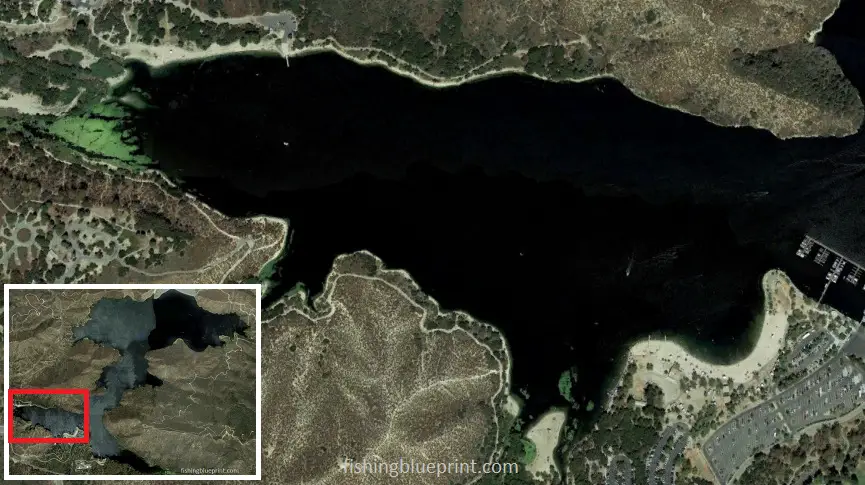
This is a long cove located in the southwest part of the lake.
It’s phenomenal for largemouth, crappie, and sunfish fishing.
The back of the cove is particularly good in the spring and summer.
It has a primary creek channel that runs down the middle and has several smaller creek ditches that drain into multiple larger creek channels.
This bay has many different structures you can target and fish.
The northern side of the Cleghorn Cove is lined with artificial fish habitats in depths of 10-40 feet of water. It’s also steeper than the south side which makes it a prime area for summer and winter fishing.
The south side slope is more tapered and also has a ton of artificial fish habitat
Moving further out into the mouth of the cove sits the old former diversion dam. The dam will hold bass and stripers in the summer which makes it great for trolling.
Located: southwest side of the lake
Structural features: vegetation, steep banks (northern), artificial habitat throughout.
Best species to target: largemouth bass, striped bass, crappie, sunfish
Most effective way to fish this spot: boat, kayak, float tube, shoreline fishing.
Miller Cove
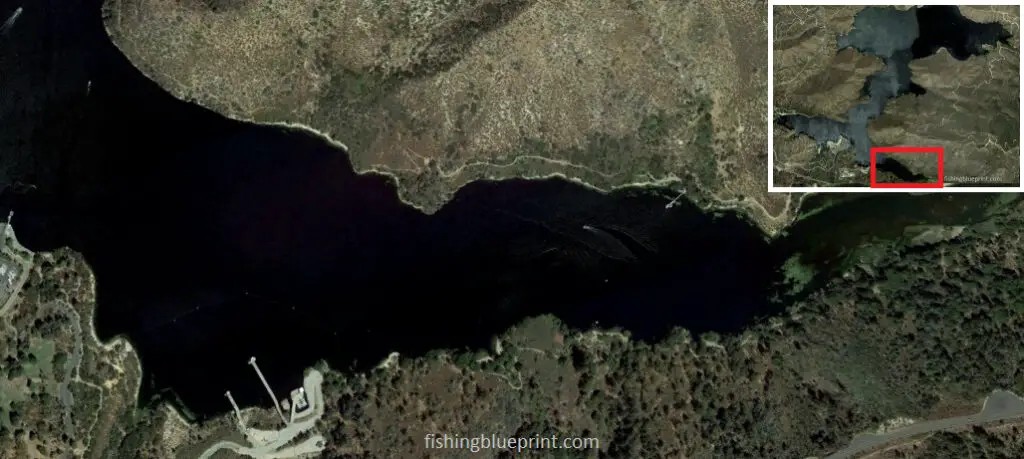
This is another long cove, this time located on the southeast part of the lake.
It’s also phenomenal for largemouth, crappie, and sunfish fishing.
The back of the cove is particularly good in the spring and summer.
It has a primary creek channel that runs down the middle and has several smaller creek ditches that drain into multiple larger creek channels.
This bay has many different structures you can target and fish.
Both sides of Miller Cove are lined with artificial fish habitats in depths of 10-40 feet of water.
Moving further out into the mouth of the cove sits the old former diversion dam. The dam will hold bass and stripers in the summer which makes it great for trolling.
Located: southeast side of the lake
Structural features: vegetation, steep banks (northern), artificial habitat throughout.
Best species to target: largemouth bass, striped bass, crappie, sunfish
Most effective way to fish this spot: boat, kayak, float tube
Rocking Chair Point

This spot is defined by a deep water point that is close to the primary river channel.
The point has multiple ledges, shelves, drop offs, and humps.
During the summer, topwater baits work really well one hour before and after the sunrise/ or sunset. A great midday strategy is to come back to this spot and scan this area with a fish finder and locate the thermocline. Chances are the bass will hold just a few feet above the thermocline. Once identified, target the point with a lure that can be used at that specific depth.
Located: southern section of the lake
Structural features: deep rocky point that is close to the primary river channel
Best species to target: largemouth bass, striped bass, crappie, sunfish
Most effective way to fish this spot: boat, kayak, float tube
The Narrows
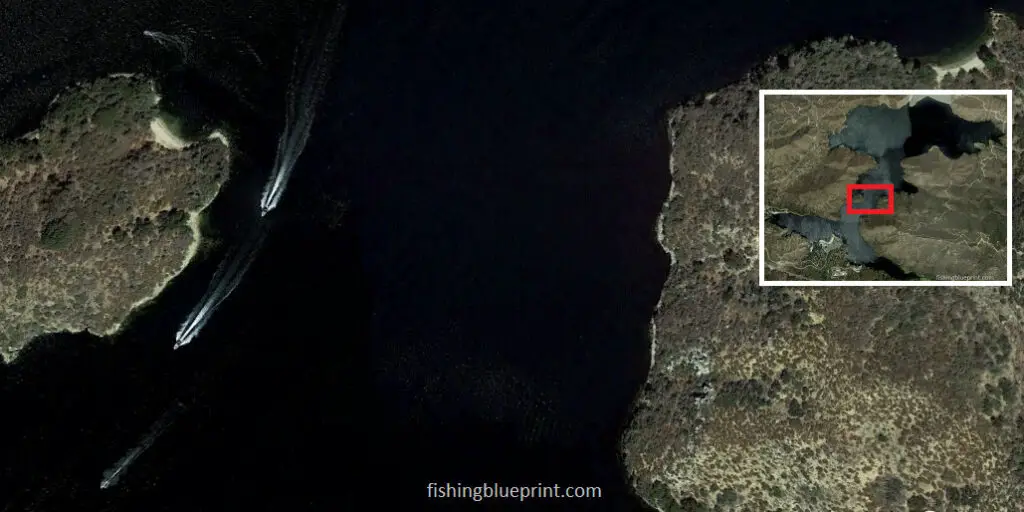
The Narrows give the anglers a long single deep channel to fish, and is an excellent place to troll for striped bass, especially in the summer.
Schools of striped bass will suspend around the river channel ledge and multiple points this area offers.
That’s why we love Silverlake Lake fishing! We fished this lake multiple times and this always came in handy!
Downriggers and drift socks aid in catching these trout that are suspended over deep water 80-150-feet deep during the late springtime all the way through late summertime.
The secret to effective striper fishing is using high-quality fish sonar to find where the bass are holding. Often it’s easier to find the school of baitfish first, then you’ll often see striped bass nearby
Below, I included a primer-blueprint to help you quickly and easily get started with striped bass fishing even if you did it before. Ready? Here we go…
If it’s windy, stormy, or if the stripers are actively feeding:
- Consider casting or trolling white or silver lipless crankbaits, silver spoons, big inline spinners, hard plastic minnow-style jointed swimbaits, and umbrella rigs that work really well.
- When the stripers are busting shad on the surface, try walking a topwater walking bait, whopper plopper, or an umbrella rig.
Don’t forget – in windy conditions you can slow your drift using a drift sock for slowing your boat down without having to drain your battery.
In calm conditions, or if the bass are not active you have a few options to target:
- Consider dropping cut frozen anchovies down to where the bass are holding in open water
- Jig a flutter spoon over the school to get them activated
- Swim or jig a bucktail hair jig over or through the school
- Swim or jig a finesse 4″ soft plastic swimbait through or over the school
Have a bright-colored crankbait ready if the striped bass dive when the boat approaches the boil; one of these tactics should deliver at least a couple of good fish.
Lastly, do you want to escape the heat? In the evenings, anchor off of points and fish deep with cut frozen or fresh anchovies. Works best when you use a green light to attract the baitfish!
Located: Southwest corner of the lake
Structural features: Steep rocky banks, deep channels and drop offs.
Best species to target: striped bass, largemouth bass
Most effective way to fish this spot: Boat, kayak, or float tube by either trolling with a downrigger,or trolling without a down rigger
Chamise Bay

This is a large open bay that is best described by having several smaller creek ditches that drain into multiple larger creek channels, all of whom are submerged. This bay has many different structures you can target and fish.
The main creek channels that drain from the bay to the main lake create underwater main lake points. Scan these areas because they will often have rocky high spots, ridges, humps, and ledges associated with them.
Moving further into the bay, make sure to scan the ditch and channel interactions. This area also has rocky high spots, ridges, humps, and ledges, along with channel swings that can hold fish.
Located: northwestern section of the lake
Structural features: deep water creek channels, rocky high spots, ridges, humps, and ledges.
Best species to target: largemouth bass, striped bass
Most effective way to fish this spot: boat, kayak
Inlet Area
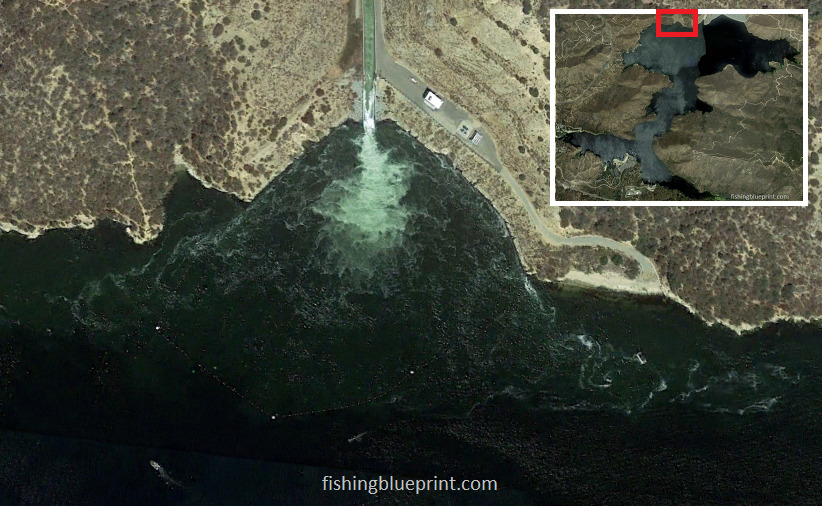
This area is a water inlet flowing into the lake.
Anytime you observe an area with a constant supply of current it should be checked for fish. The flowing water into the area brings nutrients and food for the local baitfish to eat. Naturally, the bass will follow the baitfish and pick off the sick or injured in this area.
Another important feature of this area is since it provides a constant flow of current and swirling water, it subsequently provides a constant source of oxygen. If there is a constant source of oxygen, it means the area is less likely to be affected by severe weather or seasonal changes (ex: the fall turnover) and it will attract fish all year long.
You’ll notice the locals lining the boats up along the boat boundary buoys and casting large swimbaits and umbrella rigs upstream.
Here is a list of lures that can work great in this area: topwater lures, buzzbaits, spinnerbaits, crankbaits, frog lures, umbrella rigs, jerkbaits, swim jigs, soft plastic swimbaits, chatterbaits, hair jigs, and underspin jigs.
Flutter spoons work great when used over any deep channels, points, structure, or vertical timber.
In contrast, slower-moving baits such as drop shot, football jigs, tubes, wacky rig, Texas rig, Neko rigs, and Carolina rigs can be phenomenal when the conditions are calm or the bass are not as active.
Located: northside near the dam end.
Structural features: inlet of flowing water.
Best species to target: striped bass, largemouth bass, crappie
Most effective way to fish this spot: boat
Quarry Cove & Sycamore Landing
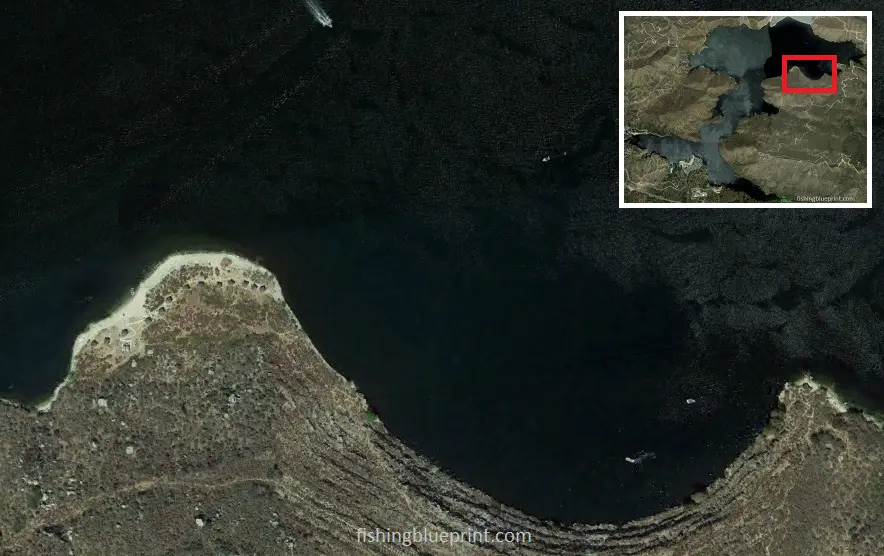
Quarry Cove is a steep rocky bank created during the construction of the Cedar Springs Dam. The bank is characteristically very steep and made from large chunk-rock to boulder-sized substrate.
Given this embankment’s large area, it’s best to focus your efforts on cuts, points, boulder piles, and transition areas from larger rocks to smaller rock size.
Sycamore Landing is a long point made up of rocky rip rap. The point is covered in thick chunk rock, which the size can range from small boulders to basketball-sized rock (also known as “rip rap”).
Naturally, crawfish, bluegill, minnows, and shad seek shelter in these types of fishing spots, which in turn attract bass and other predatory fish.
Both of these spots are phenomenal for fishing during the summer and winter.
Located: northwest section of the lake.
Structural features: steep rocky cove, long and deep chunk rock point
Best species to target: striped bass, largemouth bass, crappie
Most effective way to fish this spot: boat
Boat Ramps and Marinas at Silverwood Lake
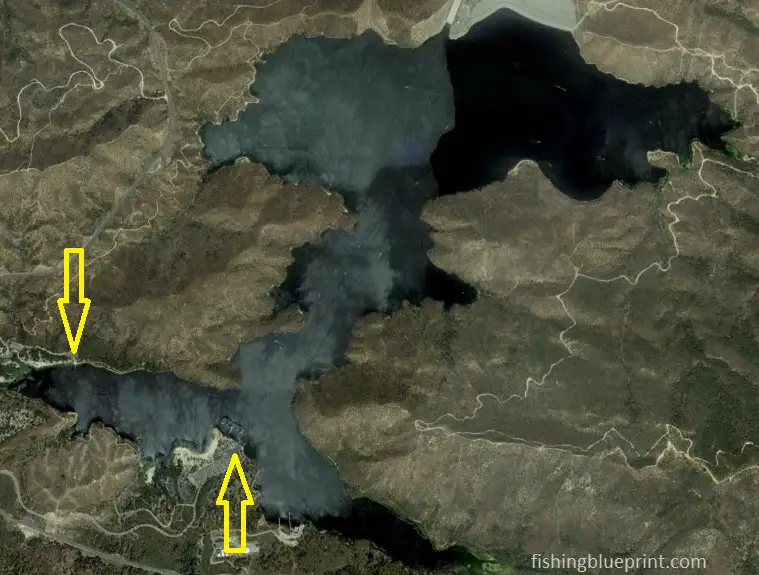
Silverwood Lake State Recreation Area Boat Launch
14651 Cedar Cir, Hesperia, CA 92345
(760) 389-2281
Lanes: 2
Restrooms: Yes
Showers: no
Groceries/snacks available: Yes
Gas: No
Camping nearby: Yes
Silverwood Lake Marina
14651 Sawpit Canyon Rd, Hesperia, CA 92345
(760) 389-2281
Lanes: 6
Restrooms: Yes
Showers: no
Groceries/snacks available: No
Gas: No
Camping nearby: Yes
Top Tackle Shops Near Silverwood Lake
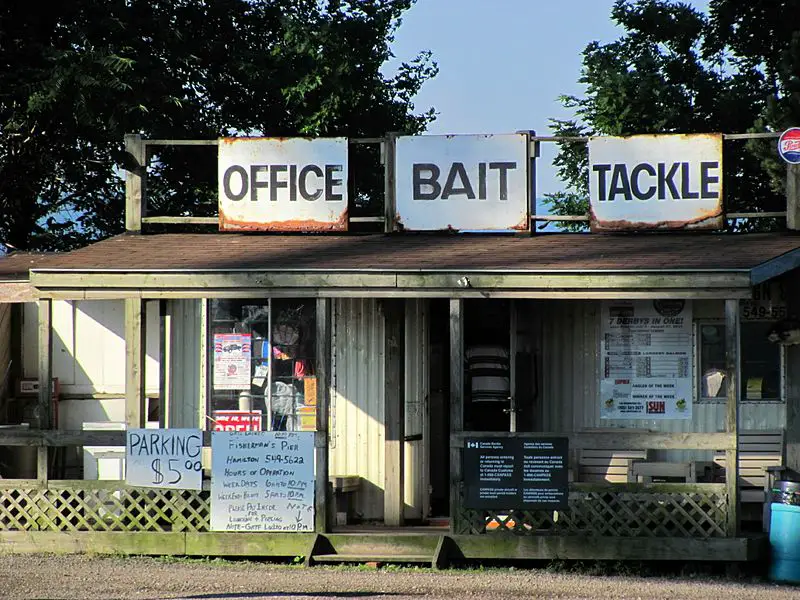
Lake Drive ACE Hardware
23895 Lake Dr, Crestline, CA 92325
acehardware.com
(909) 338-1617
Silverwood Country Store
12077 CA-138, Hesperia, CA 92345
(760) 389-2423
Walmart
4001 Hallmark Pkwy, San Bernardino, CA 92407
(909) 880-4038
Camping Near Silverwood Lake
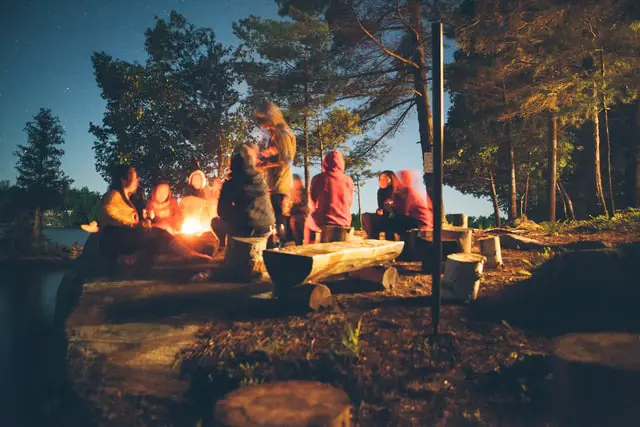
Silverwood Lake Campgrounds
Silverwood Lake has a total of one campground spread over three different lots Old Mesa Campground “A” (sites 1-65), Old Mesa Campground “B” (sites 66-95), and New Mesa Campground (sites 96-136)
- Sites – 136 total.
- RV – some have full hook-ups, whereas some have partial
- Standard sites/ tent sites available
- Dump station available: Yes
- Low season: October – March
- High season: April – September
- Pets welcome: Yes
- Fire ring – Yes
- Grill – Yes
- Drinking water – Yes
- Flush toilets – Yes
- Showers – Yes
Reservations – Silverwood Lake SRA Reservations or call (800) 444-PARK (7275)
In Summary...
As you now can see Silverwood Lake fishing can be tough at times, but it’s not impossible and with the help of the Silverwood Lake Fishing Report… It definitely helps you get started on the right foot quickly and easily, so you can avoid wasting hours wondering where and how to get started.
But Let Me Ask You a Question…
Do you now have a better sense of where you can get started, even if you have have been here? YES, we went over all the best locations to start when you get to this lake!
Do you feel that you have a good grasp of what species are in this lake? YES, we went over using multiple helpful lists so you don’t waste your time and money going after the wrong species of fish!
Do you have a good understanding what baits are needed to catch each of the different species of fish? YES, we hammered this topic several times in the fishing report what baits and lures are needed to each and every fish!
YES! That’s right!… If you made it this far you know I truly over delivered for you… I gave away secrets about this lake that I haven’t told anyone until publishing this report.
I Need To Ask A Favor From You And It’s Not Going To Cost You A Single Dime…
If you have gotten anything out of this free report; whether its knowing where to get started, what kinds of fish are in Lake Pleasant, what baits to use, where to launch your boat, where to buy a frosty beverage, where to camp, and other things to do when you’re at this lake…
Then I need you to do something that is going to help you your fellow angler…
And that is share this report. Please share it to as many people as you can. It’s free to you and it really helps me out as a creator.
THIS IS WHERE YOU CAN HELP ME THE MOST: There’s a lot of information about this subject you have found helpful, and I’m sure you’ll be able to put some of the knowledge bombs to use. But sharing this report helps drive traffic which in turn helps me at absolutely no cost to you. I love creating reports like this for you, and you like reading these types of reports please share this with your friends, family, and fellow anglers.
Click on your favorite social media buttons to share this page now!
Other California Related Fishing Articles
- Bass Lake Fishing Report
- Clear Lake Fishing Report
- Castaic Lake Fishing Report
- California Delta Fishing Report
- Diamond Valley Lake Fishing Report
- Don Pedro Reservoir Fishing Report
- Eagle Lake Fishing Report
- El Capitan Reservoir Fishing Report
- Lake Berryessa Fishing Report
- Big Bear Lake Fishing Report
- Folsom Lake Fishing Report
- Irvine Lake Fishing Report
- Lake Almanor Fishing Report
- Lake Camanche Fishing Report
- Lake Isabella Fishing Report
- Lake Havasu Fishing Report
- Lake McClure Fishing Report
- Lake Oroville Fishing Report
- Lake Perris Fishing Report
- Lake Piru Fishing Report
- Lake Skinner Fishing Report
- Lake Tahoe Fishing Report
- Los Banos Reservoir Fishing Report
- New Hogan Lake Fishing Report
- New Melones Lake Fishing Report
- O’Neill Forebay Fishing Report
- Pardee Lake Fishing Report
- Pyramid Lake Fishing Report
- San Luis Reservoir Fishing Report
- San Vicente Reservoir Fishing Report
- Shasta Lake Fishing Report
- Silverwood Lake Fishing Report
- Trinity Lake Fishing Report
- Whiskeytown Lake Fishing Report
More articles just for you...
Funny Fishing Rules, Laws, and Regulations 2025
Crazy Fishing Laws That Will Blow Your Mind! #7 is INSANE! Strange Fishing Regulations and Laws As silly as hook and rod limits may seem,
EXPOSED! How To Use A Spinnerbait The Right Way for 2025
Are You Wondering How To Use A Spinnerbait? Or How To Work A Spinnerbait Over Grass, Logs, or Points? Well, All These Questions Are Answered
EXPOSED! Best Crankbait Colors for 2025 [Which to Buy & Avoid]
What color crankbait to use? Crankbait Color Chart I just love going into a Bass Pro Shops store and just staring at all the walls
Best Underwater Dock Lights For Fishing – 2025 Buyers Guide
Night Dock Light Fishing For Beginners Dear fellow angler, Does this sound like you? You’re someone who loves fishing but just wants to escape the
15 Best Deep Diving Crankbaits [2025 Buyers Guide – Which to Buy & Avoid]
A Complete Buyer’s Blueprint On The Best Deep Diving Crankbaits for Bass, Walleye, or Striped Bass On The Market Today Fishing deep diving crankbaits can

